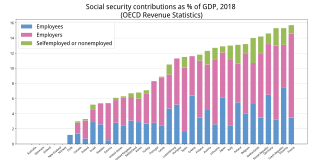
Insurance is a means of protection from financial loss in which, in exchange for a fee, a party agrees to compensate another party in the event of a certain loss, damage, or injury. It is a form of risk management, primarily used to protect against the risk of a contingent or uncertain loss.

Workers' compensation or workers' comp is a form of insurance providing wage replacement and medical benefits to employees injured in the course of employment in exchange for mandatory relinquishment of the employee's right to sue his or her employer for the tort of negligence. The trade-off between assured, limited coverage and lack of recourse outside the worker compensation system is known as "the compensation bargain.” One of the problems that the compensation bargain solved is the problem of employers becoming insolvent as a result of high damage awards. The system of collective liability was created to prevent that and thus to ensure security of compensation to the workers.

Life insurance is a contract between an insurance policy holder and an insurer or assurer, where the insurer promises to pay a designated beneficiary a sum of money upon the death of an insured person. Depending on the contract, other events such as terminal illness or critical illness can also trigger payment. The policyholder typically pays a premium, either regularly or as one lump sum. The benefits may include other expenses, such as funeral expenses.
Health insurance or medical insurance is a type of insurance that covers the whole or a part of the risk of a person incurring medical expenses. As with other types of insurance, risk is shared among many individuals. By estimating the overall risk of health risk and health system expenses over the risk pool, an insurer can develop a routine finance structure, such as a monthly premium or payroll tax, to provide the money to pay for the health care benefits specified in the insurance agreement. The benefit is administered by a central organization, such as a government agency, private business, or not-for-profit entity.

Social insurance is a form of social welfare that provides insurance against economic risks. The insurance may be provided publicly or through the subsidizing of private insurance. In contrast to other forms of social assistance, individuals' claims are partly dependent on their contributions, which can be considered insurance premiums to create a common fund out of which the individuals are then paid benefits in the future.
Social welfare, assistance for the ill or otherwise disabled and the old, has long been provided in Japan by both the government and private companies. Beginning in the 1920s, the Japanese government enacted a series of welfare programs, based mainly on European models, to provide medical care and financial support. During the post-war period, a comprehensive system of social security was gradually established. Universal health insurance and a pension system were established in 1960.
Social Security Disability Insurance is a payroll tax-funded federal insurance program of the United States government. It is managed by the Social Security Administration and designed to provide monthly benefits to people who have a medically determinable disability that restricts their ability to be employed. SSDI does not provide partial or temporary benefits but rather pays only full benefits and only pays benefits in cases in which the disability is "expected to last at least one year or result in death." Relative to disability programs in other countries in the Organisation for Economic Co-operation and Development (OECD), the SSDI program in the United States has strict requirements regarding eligibility.
The New York Disability Benefits Law (DBL) is article 9 of the Workers' Compensation Law and creates a state disability insurance program designed to provide employees with some level of income replacement in case of disability caused off-the-job.
Business overhead expense (BOE) disability insurance, also known as Business Expense Insurance, pays the insured's business overhead expenses if he or she becomes disabled. A BOE policy pays a monthly benefit based on actual expenses, not anticipated profits. It is designed for businesses that rely on a small number of people to produce revenue.
Australia's insurance market can be divided into roughly three components: life insurance, general insurance and health insurance. These markets are fairly distinct, with most larger insurers focusing on only one type, although in recent times several of these companies have broadened their scope into more general financial services, and have faced competition from banks and subsidiaries of foreign financial conglomerates. With services such as disability insurance, income protection and even funeral insurance, these insurance giants are stepping in to fill the gap where people may have otherwise been in need of a personal or signature loan from their financial institution.
In the United States, health insurance helps pay for medical expenses through privately purchased insurance, social insurance, or a social welfare program funded by the government. Synonyms for this usage include "health coverage", "health care coverage", and "health benefits". In a more technical sense, the term "health insurance" is used to describe any form of insurance providing protection against the costs of medical services. This usage includes both private insurance programs and social insurance programs such as Medicare, which pools resources and spreads the financial risk associated with major medical expenses across the entire population to protect everyone, as well as social welfare programs like Medicaid and the Children's Health Insurance Program, which both provide assistance to people who cannot afford health coverage.
Income Protection Insurance (IPI) also known as loss of earnings insurance is an insurance policy paying benefits to policyholders who are incapacitated and hence unable to work due to illness or accident. This is typically a replacement for lost income suffered by the policy holder. These policies were formerly called Permanent Health Insurance (PHI). This type of insurance does not normally cover redundancy and does not pay for medical treatment, it is designed to only pay a monthly amount to cover the loss of income by the policy holder when they are unable to work due to illness or accident.

Social security is divided by the French government into five branches: illness; old age/retirement; family; work accident; and occupational disease. From an institutional point of view, French social security is made up of diverse organismes. The system is divided into three main Regimes: the General Regime, the Farm Regime, and the Self-employed Regime. In addition there are numerous special regimes dating from prior to the creation of the state system in the mid-to-late 1940s.
German Statutory Accident Insurance or workers' compensation is among the oldest branches of German social insurance. Occupational accident insurance was established in Germany by statute in 1884. It is now a national, compulsory program that insures workers for injuries or illness incurred through their employment, or the commute to or from their employment. Wage earners, apprentices, family helpers and students including children in kindergarten are covered by this program. Almost all self-employed persons can voluntarily become insured. The German workers' compensation laws were the first of their kind.
Welfare in France includes all systems whose purpose is to protect people against the financial consequences of social risks.
Disability benefits are a form of financial assistance or welfare designed to support disabled individuals who cannot work due to a chronic illness, disease or injury. Disability benefits are typically provided through various sources, including government programs, group disability insurance provided by employers or associations or private insurance policies typically purchased through a licensed insurance agent or broker, or directly from an insurance company.
Workers' accident compensation insurance is a government insurance program in Japan. It pays benefits to workers if the insured worker suffers injury, illness, or death due to circumstances related to his or her work related duties or commuting. The workers' accident compensation insurance system is also involved in social welfare projects for workers, such as promoting the restoration of workers who have suffered injury or illness to a full role in society. It is paired with unemployment insurance and referred to collectively as labour insurance. Workers' Accident Compensation Insurance is managed by the Labour Standards Office.

The Social Security Institution is the governing authority of the Turkish social security system. It was established by the Social Security Institution Law No:5502, which was published in the Official Gazette No: 26173 on June 20, 2006. This brought five different retirement systems that affected civil servants, contractual paid workers, agricultural paid workers, and self-employed workers into a single retirement system offering equal actuarial rights and obligations.
The social security in Switzerland includes several public and private insurance plans to assist the welfare of the population.
Workers' compensation in the United States is a primarily state-based system of workers' compensation.






